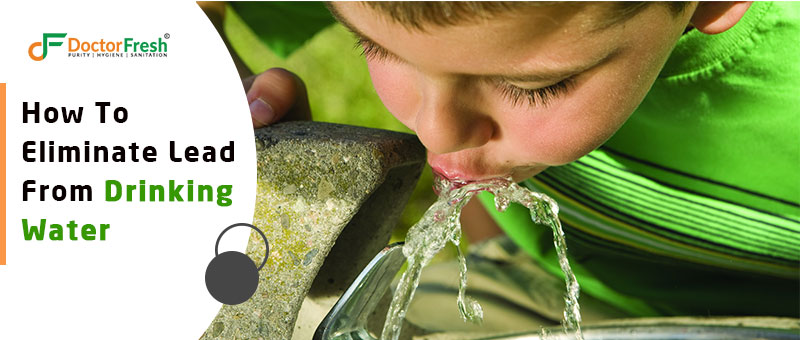You must be wondering why we need to remove leads for the water. Right?
Don't you worry!!!
Because here, we’re with the complete information on why you should remove the extra concentration of leads from water and how this can be achieved.
So if you're suffering from contaminated water having a high concentration of Lead, then this article is helpful for you.
Yes, here in this article, we will be discussing the optimum concentration of Lead in water, and later we will discuss some crucial ways to remove Lead from water. So read this till the end, and you will get all your question answered.
Now let's talk about Lead first.
Lead is a naturally occurring metal that is fetal if exposed to a high concentration. This chemical compound is toxic for both young old age people but comparatively vulnerable in young people. Once a lead reaches inside us, it affects multiple organs like the brain, kidney, liver, and bones. This naturally occurring chemical compound becomes more dangerous in pregnant women and their unborn babies as it may cause miscarriage, stillbirth, premature birth, etc.
According To The Centers For Disease Control (CDC), Almost 4 Million Home Across The United States Receives Water Having High Lead Concentration. Thus It Is A Major Concern Among The People, And It Becomes Essential To Treat Lead-Containing Water.
|
Lead mainly affects our vital organs, which can signify fatal health issues. So it has become necessary to drink lead-free water. But before we start discussing how to remove Lead from water, let's discuss how much Lead concentration in water is considered safe for human consumption. |
How Much Lead Is Safe In Drinking Water?
According to EPA (Environmental Protection Agency), the maximum level of leads should be "zero." It means no amount of Lead is safe in drinking water. Lead affects our body, but it can also accumulate over time; thus, even a low level of Lead in water can be dangerous.
We want your attention towards one fact: "lead-free" water does not ever mean that the water has "Zero" Lead. According to the Safe Drinking Water Act, a plumbing fixture is considered lead-free if it has less than a 0.25 percentage weighted average of Lead across its surface.
What Are The Harmful Effects Of Lead?
Although lead affects children's health in many ways, here we have listed some of the major health concerns, and these are
|
In Children |
In Adults |
In Pregnant Lady |
|
Brains and nervous system may get damage |
Increase risk of blood pressure |
Can cause miscarriage and premature birth |
|
May suffer from learning disabilities |
Leads to Kidney malfunctioning |
Increase risk of preeclampsia |
|
May leads to Attention Deficit Disorder (ADD) |
May cause a reproductive problem |
Low weight ne born babies |
|
Children may face both physical and mental development disorder |
This leads to joint & muscle pain |
May damage the nervous of your unborn babies |
|
May be suffering from hearing disabilities |
Can cause mood swings |
Can damage Kidney on newborn baby |
|
Can lead to the anemia |
Memory or concentration problems |
Leads to stillbirth |
How Can You Remove Lead From Drinking Water?
Lead from water can be removed by adopting various water purification methods like Reverse osmosis, distillation, and active carbon filter. However, there are various other factors which you should consider to remove Lead from water. Some of them are replacing those plumbing fixtures and pipes which contain a high concentration of Lead.
Below are some water purification methods that help you remove Lead from water. So let's discuss these purification methods in detail.
#1. Reverse Osmosis
It is one widely used water purification technology that eliminates contamination based on molecular size. The reverse osmosis-based water purification system is also known as a Reverse Osmosis water purifier.
In reverse osmosis-based purifier, a semi-permeable membrane is used, which has several tiny pores, and these pores don't allow water contamination to pass through it. So if you are suffering from the excess concentration of Lead in water, then a reverse osmosis-based system can be the best option. Click here to buy the best RO water purifier.
|
A reverse osmosis-based water purifier can remove leads up to 99.1% from water. Compared to other methods used for removing leads from water, reverse osmosis is best because it has low production cost, consumes less energy, and the best part is that it is easy to handle & maintain. |
#2. Distillation
It is again the best method to purify water. This process mimics how water gets purified in nature through evaporation in the atmosphere. First, this water is exposed to the heat source until the water starts converting into vapor; now, the vapor is redirected towards the cooling source, which converts into the water, exceptionally pure water.
#3. Active Carbon Filters
This water purification method is one of the best methods for eliminating organic compounds from water. This is because it contains activated carbon that contains several pores and an enormous surface area. So when water passes through it, the contaminant present in the water gets captured, and only clean water pass to the other size.
Note- You need to know that all the carbon filters can't remove Lead. Yes, only certified carbon filters can remove Lead, so before you buy a carbon filter, look for the NSF, i.e., National Sanitation Foundation certification, or you can also look for the Water Quality Association Certification. These certifications ensure that the carbon filter is certified for removing Lead from the water.
Do you know???
Having a trusted water purifier at your house helps you remove Lead from water smoothly. If you are concerned about lead concentration in water, then buy the best water purifier home for home and get lead-free drinking water quickly without any hassle.




